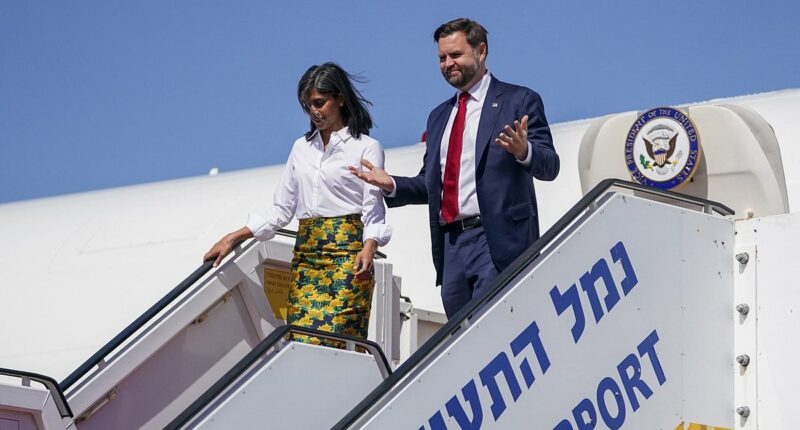Share this @internewscast.com
JD and Usha Vance have made their way to Israel amidst ongoing efforts by the Trump administration to stabilize a tenuous ceasefire in the Gaza region.
The vice president and second lady landed at Tel Aviv’s Ben Gurion Airport on Tuesday, where they were greeted on the runway by Mike Huckabee, the U.S. Ambassador to Israel.
President Trump has deployed his vice president and second lady as key figures in maintaining his delicate peace initiative between Israel and Hamas, which is under strain following Israeli military actions in Gaza. These actions were ordered by Prime Minister Benjamin Netanyahu in response to the deaths of two Israeli soldiers.
During their visit, Vance is scheduled to engage directly with Israeli Prime Minister Benjamin Netanyahu and plans to remain in the region until Thursday.
Upon his arrival, Vance conducted a meeting at the airport with key Trump administration negotiators, including Steve Witkoff and Jared Kushner, who is also the president’s son-in-law.
Later on Tuesday evening, Vance is set to host a news conference in Jerusalem. He is also expected to offer support to families of hostages still held in Gaza and to meet with those who were recently released by militants.
Earlier on Tuesday, Witkoff and Kushner met in Tel Aviv with nine hostages who were released from captivity last week.
It comes as Netanyahu warns that Hamas has failed to hand over the remains of every hostage. The chief Hamas negotiator says the group is steadfast in its resolve to honor the truce and end the two-year war.

Vice President JD Vance and Second Lady Usha Vance disembark from their plane upon arriving at Ben Gurion Airport in Tel Aviv on October 21

JD and Usha meet US Ambassador to Israel Mike Huckabee, Israeli Ambassador to the US Yechiel Leiter and Israel’s Minister of Justice Yariv Levin at Ben Gurion airport

Vance arrives at Ben Gurion Airport in Tel Aviv
Israel confirmed overnight that Hamas released the body of Tal Haimi, who was killed in the Hamas-led October 7 attack that ignited the war.
He was abducted from Kibbutz Nir Yitzhak on the Gaza border.
The 42-year-old was a fourth-generation resident of the kibbutz and part of its emergency response team. He had four children, including one born after the attack.
Under the terms of the ceasefire, Israel is still waiting for Hamas to turn over the remains of 15 deceased hostages. Thirteen bodies have been released since the ceasefire began.
The Gaza Health Ministry, part of the Hamas-run government, said that Israel transferred the bodies of 15 Palestinians to Gaza as part of the ceasefire.
The International Committee of the Red Cross handed over the bodies to the Nasser hospital in the southern city of Khan Younis, it said.
The new arrivals brought the number of bodies Israel sent back to Gaza to 165 since the exchanges started earlier this month, according to the health ministry.
After trading strikes earlier this week, Hamas negotiators reiterated that the group is committed to ensuring the war ‘ends once and for all.’
‘From the day we signed the Sharm el-Sheikh agreement, we were determined and committed to seeing it through to the end,’ Hamas chief negotiator Khalil al-Hayya, who is in Cairo, told Egypt´s Al-Qahera News television late Monday.
He said the Sharm el-Sheikh summit, hosted by Egyptian President Abdel-Fattah el-Sissi and Trump, represented ‘an international will declaring the war in Gaza is over.’

Yuval and Tom, the daughter and the brother of Ronen Engel, an Israeli man abducted from his home and murdered by Hamas in the October 7 attacks, mourn over his coffin during his funeral at the southern Israeli kibbutz of Nir Oz, on Tuesday

An aerial view shows the extensive destruction in Khan Yunis, Gaza

Palestinian children gather to receive food portions from a charity kitchen in the Nuseirat refugee camp, located in the central Gaza Strip, on Tuesday
Al-Hayya said Hamas received assurances from mediators and Trump that ‘give us confidence that the war has ended for good.’
He said Israel has complied with aid deliveries in the crossings according to the agreement but asked mediators to pressure Israel to deliver more shelter, medical supplies and winterization items before the weather changes.
Meanwhile, the head of Egypt´s intelligence agency traveled to Israel on Tuesday to meet with Israeli officials and Witkoff over the implementations of the ceasefire, according to Egyptian media.
On Sunday, Israel´s military said militants had fired at troops, killing two Israeli soldiers in areas of Rafah in southern Gaza that are under Israeli control as per agreed-on ceasefire lines.
Retaliatory strikes by Israel killed 45 Palestinians, according to the strip´s Health Ministry, which says a total of 80 people have been killed since the ceasefire took effect.
Similar strikes occurred on Monday in Gaza City and Khan Younis, where Israel said militants had crossed the yellow ceasefire line and posed an ‘immediate threat’ to its troops.
The Israeli military said Monday it was using concrete barriers and painted poles to more clearly delineate the so-called yellow line in Gaza where troops have withdrawn to. It said several instances of violence have occurred.
Also on Tuesday, Qatar, a key mediator in the ceasefire, denounced Israel in a speech by its ruling emir. Sheikh Tamim bin Hamad Al Thani said his nation would continue to serve as a mediator as a ceasefire holds in the Gaza Strip.

An Israeli tank moves along the border fence between Israel and the Gaza Strip on Tuesday

Displaced Palestinians gather to receive food portions from a charity kitchen in the Nuseirat refugee camp, located in the central Gaza Strip, on Tuesday

JD and Usha Vance board Air Force Two en route to Israel at Joint Base Andrews, Maryland, on Monday
Sheikh Tamim specifically called Israel out for its ‘continued breaches of the ceasefire’ in Gaza, as well as its expansion of settlements in the West Bank.
A senior health official in the Gaza Strip said the bodies of Palestinians that Israel returned to Gaza as part of the ceasefire deal bore ‘evidence of torture’ and called for an investigation.
Israel returned 150 bodies for Palestinians to Gaza as part of the ceasefire deal, which required the release of all of Israeli hostages – living and deceased – in return for the release of over 1,900 Palestinian prisoners and many bodies of Palestinians.
So far, only 32 of the returned bodies have been identified, according to the Gaza Health Ministry.
Dr. Muneer al-Boursh, the general director of the Health Ministry, said in a post of social media late Monday that some of the bodies had returned with evidence of being bound with ropes and metal shackles, blindfolds, deep wounds, abrasions, burns, and crushed limbs.
‘What has happened constitutes a war crime and a crime against humanity,’ he said, calling for the United Nations to launch an ‘urgent and independent international investigation.’
The Israel Prisons Service denied that prisoners had been mistreated.
‘All inmates are held according to legal procedures, and their rights including access to medical care and adequate living conditions are upheld by professionally trained staff,’ a spokesperson for the prison services said.
Israeli hostages released from Gaza have also reported being bound by metal shackles and harsh conditions, including frequent beatings and starvation.




